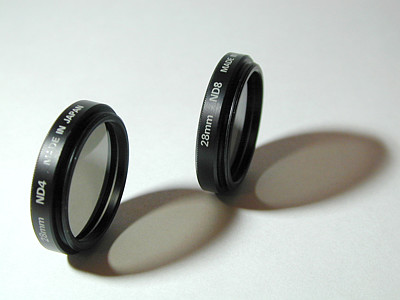
The main purpose of using neutral density (i.e., ND) filters is to reduce the amount of light that can pass through the lens. As a result, if a shutter speed is kept the same, after adding a neutral density filter, a larger aperture must be used to obtain the same exposure. Similarly, if an aperture is kept the same, after adding a neutral density filter, a slower shutter speed must be used to obtain the same exposure. This can be seen in the following diagram. Note that this diagram was discussed in the Program Mode (950, 990 and 995).

Recall that the thick red line indicates a constant exposure value (i.e., EV). To achieve this "correct" exposure, there are many different aperture-shutter speed combinations. After adding a ND filter, the exposure value is reduced because there is less light passing through the lens. This is shown as a dashed line in the above figure. Thus, if we want to keep the original shutter speed (without using a ND filter), aperture has to be wider; or, if we want to keep the original aperture, shutter speed must be slower.
Different ND filter manufacture many use a different way to indicate the amount of light a ND filter can reduce. There are two typical systems as shown below:
| Density | 0.1 | 0.2 | 0.3 | 0.4 | 0.5 | 0.6 | 0.7 | 0.8 | 0.9 | 1.0 | 2.0 | 3.0 | 4.0 |
| Reduction by f-stops |
1/3 | 2/3 | 1 | 1 1/3 | 1 2/3 | 2 | 2 1/3 | 2 2/3 | 3 | 3 1/3 | 6 2/3 | 10 | 13 1/3 |
For example, Tiffen and B+W have 0.3, 0.6 and 0.9 ND filters for reducing one, two and three stops of light. Hoya, on the other hand, uses 2×, 4× and 8× to indicate reducing 1 (i.e. 2=21), 2 (i.e., 4=22), and 3 (i.e., 8=23) stops. The two ND filters come with Nikon's Coolpack are of ND4 and ND8 type, which means they reduce two and three stops, respectively.
All ND filters are gray in color. The deeper the color, the stronger the effect (i.e., reducing more light). The following shows Nikon's ND4 (font) and ND8 (rear) filters. From the shadows, it is clear that a ND8 blocks more light than a ND4 does.

Based on this understanding, ND filters help us in at least three situations: (1) reduce the intensity of light; (2) use slower shutter speed; and (3) use larger aperture. We shall discuss each of these situation briefly below.
Nikon Coolpix 950, 990 and 995 have smallest aperture (resp., fastest shutter speed) f11.4, f11 and f10.3 (resp., 1/750, 1/1000 and 1/2000). Occasionally, it is possible that a correct exposure cannot be achieved even with the smallest aperture and fastest shutter speed. In such cases, ND filters become useful, because they can reduce the intensity of the light so that a photo can be taken within the limit of your camera. This is actually a common situation when film cameras and high speed films are used.
Reducing the intensity of light means we can either use a slower shutter speed or a larger aperture. A slower shutter speed can cause moving objects blurred (i.e., motion blur) which creates a sense of motion. The following images were taken using the Aperture-Priority Mode (950, 990 and 995). The aperture was set to F2.8, the largest possible aperture, so that shutter speed can be reduced properly. The left image below was taken without a ND filter, and, as you can see, the truck (running about 40 miles) is frozen. Adding a ND4 filter to reduce 2 stops (i.e., slowing the shutter speed to a quarter of that used for the left image), the vehicle shows motion blur (middle image below). Motion blur becomes even more significant if ND8 is used instead of ND4 (right image below) which reduces the shutter speed to 1/8 of that used for the left image.
| |
|
|
| Without ND | With ND4 filter | With ND8 filter |
| Click on the icon to see a larger image | ||
Note that a number of ND filters can be stacked up to further reduce the intensity of light. The following image was taken by using both the ND4 and ND8 filters. This reduces the intensity of light to 1/32 (i.e., 5=2+3 stops) of the original. Now motion blur is so obvious even in a small image.
| |
| With both ND4 and ND8 filters |
| Click on the icon to see a larger image |
| |
|
|
| Without ND | With ND4 filter | With ND8 filter |
| Click on the icon to see a larger image | ||